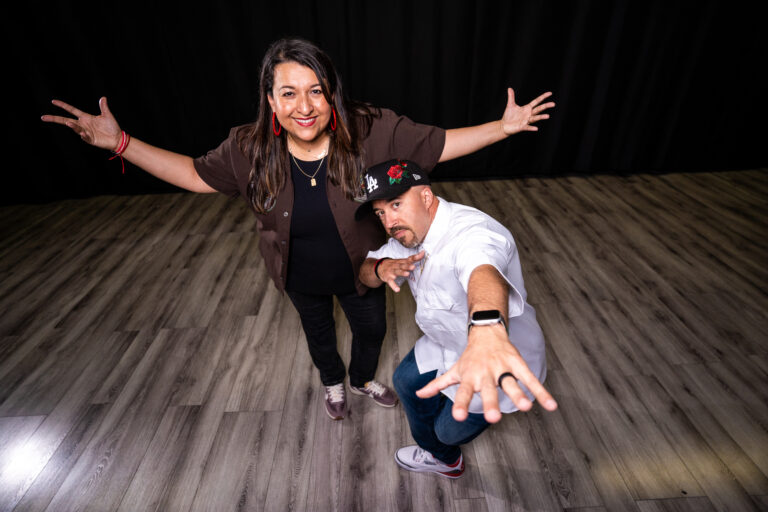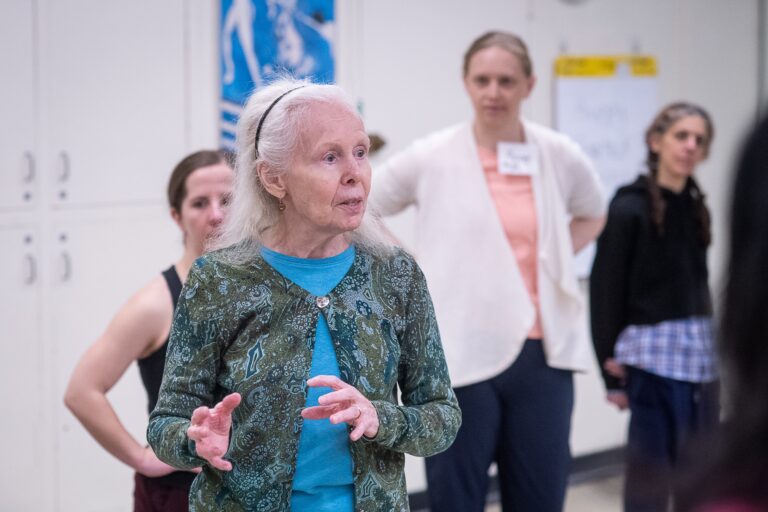Even Balanchine had a few false starts before he launched New York City Ballet. Advance planning and a thoughtful approach can give you the necessary boost to help survive the difficult first years. In this first part of a series, DT explores the complex process of getting a dance company off the ground, from conceptualizing goals to raising seed money.
Starting a dance company is a little like having a child: It takes a lot of energy, involves sleepless nights and is definitely a labor of love. In both endeavors, there are inevitably critics who will hint that you don’t know what you’re doing. And it always ends up being both a lot more work and a lot more fun that you ever imagined.
Defining Yourself
Having the motivation to create a company is the easy part, as dancers and choreographers are often looking for a way to perform and create new works. But when the time comes to put on a concert, the level of complexity skyrockets. “You can decide you have a company and get your friends to dance for you,” attests Kathleen Dyer, artistic director of New York City–based modern dance troupe KDNY. “But when you actually have to have a season, you need more information.”
There are several key questions to ask in the early stages, although it’s never too late to revisit these topics. The goal is to define your company’s mission; the more specific you can be in expressing your objectives, the better. Maintaining flexibility, however, is an important part of artistic growth.
Consider such subjects as:
-Why am I starting a company?
-What do I hope to achieve?
-What will set this company apart from existing companies?
-Why does the community need this kind of company?
When you are narrowing down the concepts that will be your company’s raison d’être, keep in mind a distinctive approach can bring a wider range of opportunities. “Companies run into a problem of becoming cookie-cutter,” says F. Randolph Swartz, president of Stagestep and artistic director of Dance Affiliates, a presenting organization in Philadelphia. “Presenters simply say, ‘I’m just going to take the best company I can.’ That means that the second and third tier companies, the smaller companies, never get any work.” Take a look at the programs being presented at local venues and make sure you will be offering something unique to the general public.
Help your company stand out by, for example, creating repertory that draws upon the unique history or culture of the area where you will be based (such as a Louisiana-based company incorporating Cajun music), or upon your own cultural or ethnic heritage. Or focus on making the movement itself unique. NYC-based Decadance Theatre takes the latter approach: The company is an all-female troupe that performs hip-hop ballets in a concert dance setting. “We’re trying to show that hip hop can tell all different kinds of stories,” explains Artistic Director Jennifer Weber. “Hip hop is a language that can go beyond what most people use it for.”
Developing a troupe with a distinctive style requires a period of intense creativity that cannot be forced into a compressed time frame. Bringing a work to the stage also involves many artistic decisions that indelibly frame the movement: costumes, venue, music, sets and lighting. As theaters are often booked months if not a year in advance, many new companies spend a year gearing up for the first concert season.
Looking at Financial Realities
Once you have a working idea of your company’s overarching goals, it’s time to take an unflinching look at whether or not it is a viable financial enterprise. This requires another set of questions:
-How will your company be funded?
-Are there suitable and affordable venues in your area for rehearsing and performing?
-Are there local dancers and administrators who will be able to realize your company’s vision?
-Is there an audience that will be interested in and attend the company’s performances?
These are the kinds of nuts-and-bolts issues that seem straightforward but often raise more questions than they answer. Developing a three- to five-year plan—a blueprint for action—can help keep plans and dreams grounded in reality.
A budget, mapping out your company’s expenses and income, is an important component of the plan. There are generally many more types of expenses than income. It’s impossible to predict every expense, but in thinking through an average day of rehearsals and an average performance weekend, hour by hour, and noting all the different expenses likely to be incurred by everyone involved with your company, you can anticipate much of what you’ll need to spend. You can then come up with an estimated budget for the company.
Income is generally divided into earned and contributed income. Earned income can include revenues from ticket, concession and program advertisement sales, as well as performance and workshop fees. Contributed income consists of donations or grants. Included in the expense portion may be personnel costs for dancers and administrators (as well as taxes and insurance, if they are considered employees); fees to designers, musicians, stage crew, sound engineers, videographers, photographers, graphic designers, lawyers, accountants and publicists; theater, rehearsal space and office rental fees; production costs for costumes and sets; publicity and marketing costs; website creation and maintenance costs; travel costs; and miscellaneous items such as the printing of programs or telephone expenses.
Raising Start-up Funds
How do you begin to raise the funds necessary for all these expenses? And how much should you have in the bank before you even step into the studio? “In an ideal situation, you should raise sufficient money to run your dance company for a year without any box office [proceeds],” says Swartz. “You should have that money in your pocket. Cash flow is an important part of putting together your dance company. Many companies go out of business because they’ve got performances coming up soon, but they’ve got to buy costumes now, they’ve got to put a theater deposit down now and they don’t have the money. So the event doesn’t take place and they crash and burn. They would have sold the tickets if they could have held the event.”
Raising money before you have established a reputation can seem like a catch-22, but it’s not impossible. Begin building community interest in your company and fundraise at the same time by presenting a studio showing or a small concert in a donated space. Charge an admission fee and solicit donations by, say, holding a silent auction. This is the path many now-established companies took in their fledgling days. “Hubbard Street started out as a school that did performances for nursing homes,” recalls Swartz. “I remember the beginning of the Pennsylvania Ballet; its first performance was a showing on someone’s estate.”
To be able to apply for corporation and government grants, your company needs nonprofit status. (The decision of whether or not to become nonprofit and how to go about it will be explored in an upcoming issue, as will the basics of fundraising for a small company.) For-profit companies can accept gifts of cash or in-kind donations, but donors are not able to write off the gifts as a tax deduction, and the company may have to report the gifts as income.
Hiring the Dancers
With funds secured, you can start to shape your actual company. The process of finding dancers differs greatly from troupe to troupe, with some relying on word of mouth, others holding formal auditions and yet others actively recruiting dancers from local studios. Weber doesn’t like auditions, because she finds it difficult to determine how the dancers will mesh with the company in a formal setting. Dyer, a graduate of Florida State University, has relied upon an extensive network of alumni to fill her company.
A contract specifying dancers’ commitment to the company during a specific time period (even if the dancers are not being paid) can help lessen dancer turnover, which can be a big problem in small companies, especially as most performers have to hold down other jobs to make ends meet. Although a contract does not have to be in writing to be legally binding, a written contract can help formalize the relationship between dancer and artistic director. “A lot of my dancers were also my friends,” says Dyer, who contracts dancers for one-year periods. “There can be a lot of backtalk when you are working with your peers. You really have to negotiate how you direct them.”
Take this dancer-director relationship into consideration when deciding whether you, as the director or choreographer, will also perform. Although choreographers understand their own motivation better than anyone else and thus can bring a unique quality to the stage, it can be difficult to juggle the roles of director and performer in works with multiple dancers. While the choreographer/dancer knows the steps intimately and can easily make decisions on the fine points of movement, maintaining a clear view of the overall work is more of a challenge due to the split focus.
Building the Repertory
Equally important as finding the right dancers is developing the right repertory; the two, in fact, are inextricably linked. A troupe of 10 might look insignificant trying to stage a classical Sleeping Beauty, but could make a bold statement with a high-energy, contemporary program. From the presenters’ perspective, says Swartz, a “hook” is what they’re always looking for: “The work that you know is a slam dunk. The audience is going to walk out of the theater buzzing, no matter what happened the other 85 minutes. Every successful company has one of them—or more. All you have to say is Revelations or Caught and you know the company that dances it.”
Successful hooks are not limited to companies with the stature of Ailey or Parsons Dance Company. Decadance Theatre had just such a piece in its Firebird. Changing the setting to modern times, Weber sampled Stravinsky over hip-hop music and used hip-hop and breakdancing moves to tell the tale. “That piece brought us whole new audiences, because we have people who are interested in hip hop, people who are interested in ballet and people who are interested in different kinds of crossover art,” says Weber.
If all goes according to plan, a dance company can bring people together in the same way that a new baby brings a family closer. From audience members and supporters to the dancers and administrators, each dance company creates a small community with a shared passion. “My husband does a lot, my friends do a lot, my family does a lot,” says Dyer. “I am a major do-it-yourself person, but you can’t be that way with a dance company. You’re not going to do this by yourself.” DT
Caitlin Sims is the Editor at Large of Dance Teacher and Dance Spirit magazines.



